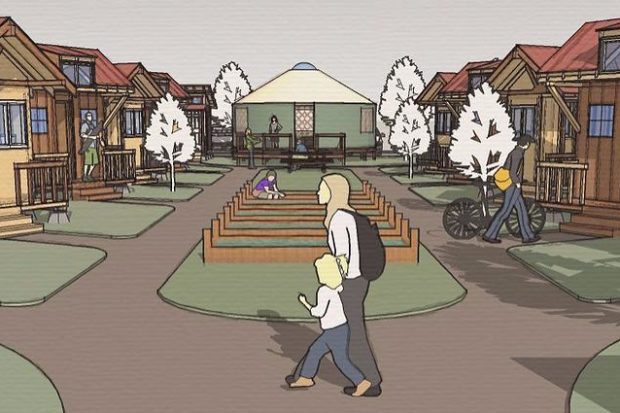
By Ron Martin
Opportunity Village Eugene (OVE) in Oregon is nestled among lumberyards and warehouses at 111 Garfield Street. It houses about 30 formerly homeless men and women in small, tall volunteer-built wooden houses and in shelters of plastic draped over half hoops set on wooden pallets as their floors and foundations.
Lisa, the woman doing gate duty in late October, declared that one of the OVE’s claims to fame is that it was built for under $100,000. The OVE includes bathrooms in the shelters, a shower house, small kitchen buildings connected by a sheltering tarp and a canvas yurt for activities of the community including computer work and group meetings for democratic governance, with a small library. It includes the dollar per year that the City of Eugene collects to rent the acre of land for it.
After the first-year lease, Eugene renewed the lease for two more years. Yet everything on the property is built to be easily movable on trucks if there is a decision to relocate the OVE.
Residents each pay $30 per month to stay, to defray some expenses, which includes electrical power, yet the village is not financially self-sufficient, even though the shelters are not heated or cooled, despite Oregon’s cold climate.
Residents buy their own food, which they store in the kitchen shelter and its refrigerators, and can cook it on gas camping stoves under the tarp. Water is available at a central faucet, with no sink basin below it.
The computers used in the yurt indicate that Wi-Fi is another available utility. There are plans to allocate half of each resident’s rent payment to be saved in an account for them to use when they depart the village for other circumstances.
Lisa described the community as having two factions that have emerged during the governance processes: 20% who are eager to leave the community as soon as they can get a job and a paycheck, and in the meantime to earn through small-business activity such as making and selling art works and baking pastries in a church kitchen; and 80% who are satisfied with life in the OVE, are ready to live out their lives there, and oppose business plans that might interfere with that existence.
Another village, Emerald Village Eugene, is in the planning stage. Planning for the community is overseen by a group of pastors, who do its fund-raising. The connecting organization to uniting them is called Square One Villages. The organization has two Web sites: www.opportunityvillageeugene. org and www.squareonevillages. org.
The basic ideas of the community are set forth in two books, Tent City Urbanism: From Self-Organized Camps to Tiny House Villages by Andrew Heben (2014) and Pocket Neighborhoods: Creating Small-Scale Community in a Large-Scale World by Ross Chapin and Sarah Susanka (2011). The books are not yet in San Joaquin Valley libraries but are available through Amazon.
*****
Ron Martin is part of Homeless Advocates, a group informing the Fresno City Council about options for sheltering our homeless population. He leads a small-group Bible study at Fresno’s First Baptist Church. He leads Fresnans against Fracking and is on the Executive Committee of the Tehipite Chapter of the Sierra Club. Ron works at the Fresno County Library’s Downtown Branch after previously working at the Woodward Park branch and driving the bookmobile for six years.
